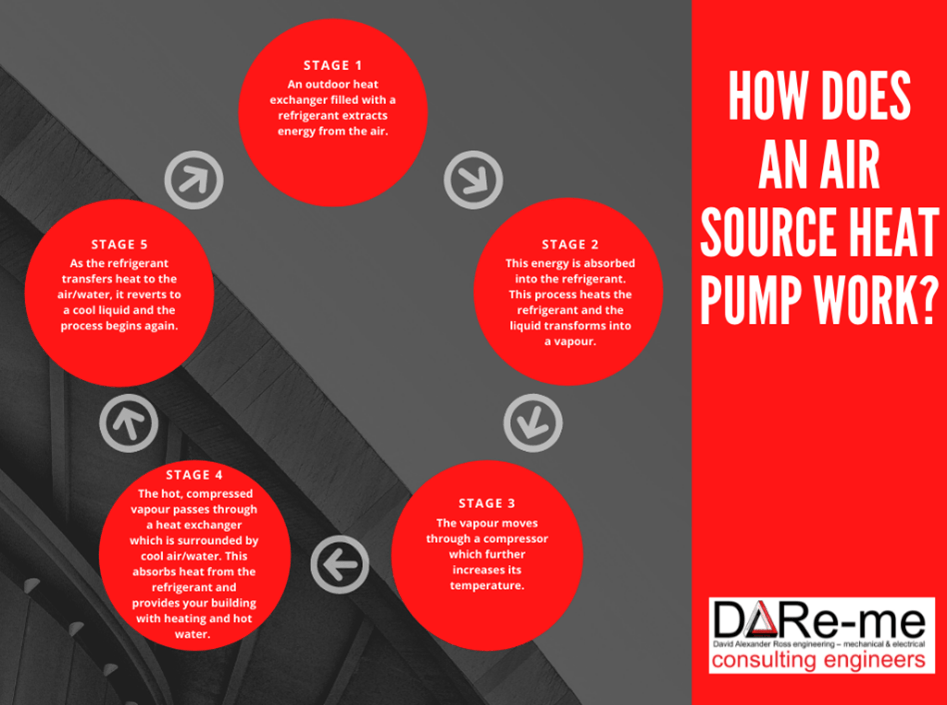A Guide to Air Source Heat Pumps
Is this heating system the right fit for you? View our guide to decide if ASHPs best suit your project.
What is an Air Source Heat Pump?
An air source heat pump (ASHP) is an energy efficient heating system which absorbs energy from the air. Though they require electricity, the heat they generate is greater than the electric input. Resultantly, ASHPs can have lower running costs than traditional heating systems.
While ground source heat pumps require large areas of outdoor space, ASHPs need much less making it a more favourable option for many businesses limited by budget and space restrictions.
Unlike conventional boilers, ASHPs produce heat at lower temperatures over sustained periods of time. There are two main types of air source heat pumps: 'air-to-air' and 'air-to-water'.
Air-to-Air
'Air-to-air' heat pumps require a warm air circulation air system to pass the warm air through your building. These heat pumps can either provide heating or both heating and cooling when using a reversing valve. This system will not provide hot water.
Air-to-Water
On the other hand, 'air-to-water' heat pumps extract renewable heat from outside air and convert this to water, providing both heating and hot water. This is more commonly used in the UK.
How do they work?
Stage 1: An outdoor heat exchanger filled with a refrigerant extracts energy from the air.
Stage 2: This energy is absorbed into the refrigerant. This process heats the refrigerant and the liquid transforms into a vapour.
Stage 3: This vapour moves through a compressor which further increases its temperature.
Stage 4: This hot, compressed vapour passes through a heat exchanger which is surrounded by cool air or water. As the cool air/water passes through, it absorbs heat from the refrigerant. This circulates around your building to provide heating and hot water.
Stage 5: As the refrigerant transfers heat to the air or water, it reverts to a cool liquid and the process begins again.

How much does an ASHP cost?
An ASHP costs more than a traditional heating system, with installation costs ranging from £7,000 to £13,000. Although initial costs are large, these are counteracted by their typically low running costs. As ASHPs produce higher levels of heat than electricity they use, they are energy efficient and cost-effective.
Moreover, homeowners in possession of an air source heat pump may be eligible for the Domestic Renewable Heat Incentive grant. This scheme provides financial payments to British homeowners for seven years for the renewable heat they generate, counterbalancing the high installation costs of an ASHP.
What are the advantages?
- ASHPs typically have lower running costs than traditional heating systems
- An energy efficient heating and hot water system, reducing your carbon emissions
- Long lasting and low maintenance
- Particularly beneficial when used for large radiators or underfloor heating as they perform best when delivering low temperatures over a long period
What are the disadvantages?
- Require outdoor space
- Large installation costs (though these are counterbalanced by their low running costs)
- Produce lower temperatures than other boilers so insulation and large radiators best compliment this system
Summary
If you are looking for a cost-effective, energy efficient heating and hot water system and have adequate outdoor space, then an an air source heat pump is likely the right fit for you. This system produces low temperatures over long periods of time, so performs best within well-insulated buildings, underfloor heating projects and in buildings with large radiators.
If you are interested in installing an ASHP within your project, contact DARe-me Consulting Engineers today.


